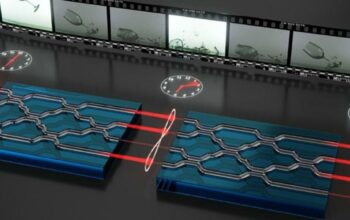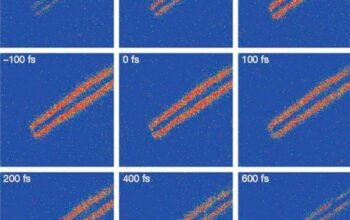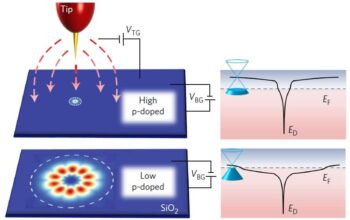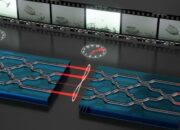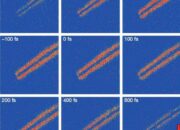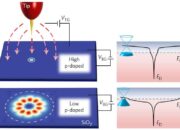Graphene, an allotrope of carbon consisting of a single layer of atoms arranged in a two-dimensional honeycomb lattice, has captivated the scientific community since its isolation in 2004. Its unique properties, stemming from its atomic structure, promise a revolution in various domains, including electronics, materials science, and even medicine. Yet, one of the most captivating aspects of graphene lies in its interaction with electrons, particularly their ability to exhibit magnetic properties under certain conditions. Understanding the underlying principles governing this phenomenon can yield profound insights into the future of materials science.
To comprehend how electrons in graphene can behave as magnets, it is crucial to explore graphene’s electronic structure. The carbon atoms in graphene are sp2 hybridized, which results in a planar arrangement with strong covalent bonds. This configuration facilitates delocalized π electrons, providing the basis for graphene’s extraordinary electrical conductivity. The band structure of graphene reveals a zero bandgap semimetal nature, where the conduction and valence bands touch at the Dirac points. This unique characteristic allows electrons to behave similarly to massless particles, endowing graphene with remarkable electronic properties.
Under typical circumstances, electrons are charged particles, which do not display intrinsic magnetic behavior. However, when exposed to specific perturbations, such as impurities, defects, and external magnetic fields, electrons within graphene can acquire localized magnetic moments. This phenomenon leads to the emergence of ferromagnetism or antiferromagnetism in certain configurations. Such magnetic properties are underpinned by the interactions between unpaired spins of electrons, transformed from a state of collective behavior to isolated magnetism in specific conditions.
One significant means of inducing magnetic behavior in graphene involves the introduction of transition metal atoms into its lattice structure. Compounds such as Mn2Ga and Fe-doped graphene have exhibited ferromagnetic properties at room temperature. Herein lies a remarkable intersection of chemistry and physics, wherein the presence of these transition metals alters the electron’s spin orientation, facilitating the alignment and stabilization of magnetic domains. Consequently, an otherwise non-magnetic material transforms into a magnet, engendering an array of potential applications in spintronics—a field that exploits electron spin, in addition to charge, for data processing and storage.
Additionally, the presence of defects or vacancies within the graphene lattice significantly impacts its electronic and magnetic properties. For instance, when vacancies are introduced, unpaired electrons localize at these sites, creating localized magnetic moments. The interaction of these moments can lead to collective magnetic ordering depending on the spatial arrangement and density of the defects. The tunability of graphene’s magnetic properties through intentional defect engineering presents an intriguing avenue for researchers exploring customizable materials.
The combination of these phenomena leads us to consider the theoretical framework governing electron interactions within graphene. Exchange interactions, primarily stemming from the Heisenberg model, elucidate the mechanisms through which electron spins interact. These interactions influence the energetics of spin alignment, rendering options for ferromagnetic or antiferromagnetic coupling based on the system’s configuration. Modifications such as electrical gating can dynamically adjust the electron density and energy levels, allowing for innovative approaches in controlling magnetic behavior.
Moreover, it is essential to explore the implications of magnetism in graphene-based materials for practical applications. In the realm of electronics, graphene’s potential integration into spintronic devices offers pathways towards faster, more efficient computing, utilizing spin manipulation for data processing. The development of magnetoresistive devices that function at room temperature presents exciting possibilities for advancement in magnetic storage technologies, among other applications.
Furthermore, the revolutionary aspect of graphene lies not merely in its existing properties but also in the layered construction technique that permits the combination of various two-dimensional materials. By stacking graphene with other magnetic materials, it is feasible to engineer heterostructures that cater flexibility in tailoring magnetic responses. This approach can lead to hybrid systems that harness the enhanced electronic properties of graphene alongside valuable magnetic characteristics from other materials.
The surprising capacity for electrons in graphene to act as magnets raises a broader dialogue about the nature of magnetism and the potential for new paradigms in materials science. This interplay of structure, defect management, and electronic behavior totters on the edge of what we perceive as classical magnetism, prompting a reevaluation of established concepts. Experiments probing the conditions necessary to elicit magnetic behavior in graphene continue to reveal a wealth of information, hinting at undiscovered phenomena ripe for exploration.
In conclusion, graphene’s potential to host magnetism through the manipulation of electron behavior positions it at the forefront of contemporary materials research. As scientists delve deeper into the intricate dynamics of electrons within this remarkable allotrope, we stand on the precipice of unprecedented innovations. The shocking truth about graphene lies not only in its remarkable physical properties but also in its capability to upend our understanding of magnetic behavior at a fundamental level. The future of materials science beckons, replete with possibilities previously confined to theoretical conjecture, now becoming tangible through the alluring versatility of graphene.

